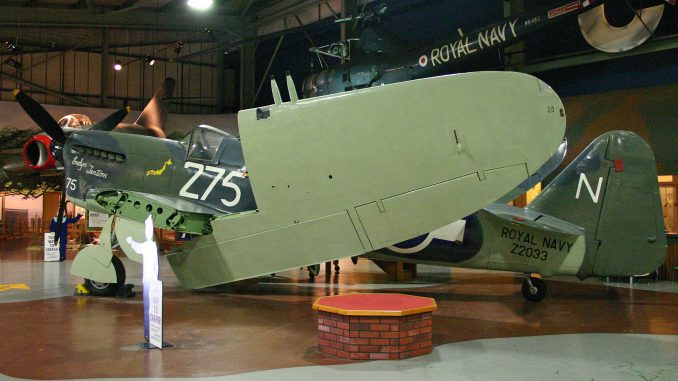
The Fairey Firefly was one of WWII’s unsung aircraft, appearing perhaps too late to have a real impact on the Royal Navy’s efforts in the Pacific Theatre. That being said, it did serve as the backbone of the Fleet Air Arms long range fighter-reconnaissance fleet in the immediate post-war era. It also enjoyed some export success, including with military air arms in Canada, Australia, the Netherlands, Denmark, India, Ethiopia, Sweden and Thailand. It is perhaps because of its use internationally that so many Fireflies survive today in comparison to contemporary WWII British naval types. Even so, just twenty or so examples remain. Only two Fairey Fireflies are flying today, although a handful are under airworthy restoration. One beautifully restored example on static museum display is with the Royal Navy’s Fleet Air Arm Museum in Yeovilton, England. Our good friend John Parker at Warbirds Online paid a visit to the museum this past summer and wrote the following article describing this magnificent aircraft, restored to represent a British Pacific Fleet combat veteran…
Fairey Firefly TT.1 at the Fleet Air Arm Museum
by John Parker
One of my favorite aircraft in the collection is the large and brutal looking Fairey Firefly TT1 (Z2033). The Fleet Air Arm Museum has another later variant of the Firefly on display, AS Mk.V WB271, however Z2033 is a genuine WWII veteran having been constructed in early 1944.
The Firefly was an attempt to construct a heavy fleet fighter powered by the 1,730 hp Rolls-Royce Griffon IIB liquid-cooled V12 engine. It was quite successful as a design and saw post war service in a number of countries, including Australia, in later versions. The British and Australian Navies even flew the type in the Korean War.
- Fairey Firefly TT1 Z2033
- Fairey Firefly TT1 Z2033 2014
- Displayed in markings of Firefly DK431
- FAAM Cobham Hall 2006
Z2033 is displayed in a WWII color scheme in Pacific Theatre camouflage with the markings of Firefly DK431 of No.1771 Naval Air Squadron when embarked aboard the aircraft carrier HMS Implacable. She wears the fuselage code ‘275’ and Implacable’s designation letter ‘N’ on the tail, however she still retains her original serial number, rather than DK431.
The Firefly is a large aircraft. To accommodate the type on smaller WWII Fleet carriers its wings fold outboard of the undercarriage. The striking grey and green upper camouflage with light grey undersurfaces make the aircraft just “look right.” The aircraft also carries the nose art which features a map of Japan and the name Evelyn Tentions, clearly a word play for “Evil Intentions”. Lt Cdr MacWhirter, 1771 Squadron’s commanding officer, flew Evelyn Tentions from HMS Implacable on ground attack missions over Japan in July 1945.
- The sole surviving Fairey Fulmar at Yeovilton in 2014
- Another view of the Fairey Fulmar at the FAAM in 2014
Fairey Firefly TT1 (Z2033) History
Z2033 rolled off the production line as a Mk.I from Fairey Aviation’s satellite factory in Hayes, Middlesex in early 1944. Fairey delivered the aircraft to No 15 Maintenance Unit at Wroughton on April 30th, 1944. In March 1945 was on the books with 731 NAS at Royal Naval Air Station East Haven in Carnoustie, Scotland. In August that year, she was involved in an accident when her pilot, S/Lt RE Patterson RN, taxied the starboard wing into a parked vehicle. Z2033 underwent repairs with Fairey Aviation, initially at their facility in Hamble, Hampshire and later at Ringway, near Manchester, Lancashire. Albert Eyskens performed her first post-repair test flight on April 1st, 1946.
- Fairey Firefly TT1 Z2033 when at Duxford in 1998
- Firefly DK431 “Evelyn Tentions” of No 1771 Squadron aboard HMS Implacable during WWII
Z2033 took part in the post-war Firefly Trainer Development Program at Ringway and later at Boscombe Down marked as G-6-3, serving as a mock-up and a spin-trials airframe. The testing took place at both Ringway, and Britains primary air-test facility at Boscombe Down, commencing on April 29th, 1946 and finishing up in September, 1947. The Firefly continued to take part in various trials until late 1948. By that point the Firefly was essentially surplus to requirements, and the company sold the aircraft to the Swedish firm Svensk Flygtjänst AB in early 1949 for use as a target tug in their contracts with the Swedish Air Force. On February 15th, 1949, Fairey’s legendary test pilot, Peter Twiss, performed Z2033’s Swedish delivery flight. The aircraft operated on the Swedish civil registry as SE-BRD and flew routine tasks with Svensk Flygtjänst AB for a further 15 years before her retirement. The now-defunct Skyfame Museum then acquired the Firefly, and flew her on May 5th, 1964 from Gothenburg, Sweden to Skyfame’s base at Staverton in Northamptonshire, England. Z2033 joined the UK civil registry as G-ASTL. Sadly, the Skyfame Museum closed its doors in 1978, whereupon the Firefly moved to the Imperial War Museum’s then newly-established facility at Duxford. She was on display there for many years, before the Fleet Air Arm Museum gained her for their collection at the turn of the new millennium. The aircraft made the journey by road to her new home in Yeovilton, Somerset on July 25th, 2000. She initially went into storage at the museum’s Cobham Hall, but after a period of refurbishment, the Firefly went on display in Hall 2 with the museum’s other WWII-era aircraft, including several other Fairey Aviation types.
Fairey Firefly TT1 (Z2033) is a very attractive exhibit and well worth a visit to the Fleet Air Arm Museum at RNAS Yeovilton UK.
Many thanks again to John Parker and Warbirds Online for the use of this article!









Be the first to comment
Graphic Design, Branding and Aviation Art